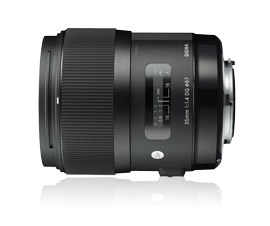Introduction
With a lofty overall DxOMark score of 39 when measured on a Nikon D800, the Sigma 35mm f/1.4 DG HSM is currently the highest scoring 35mm single focal length lens in our database.
With a 23P-Mpix score, the Sigma is one of the sharpest 35mm lenses you can buy for the 36-Mpix Nikon D800. The sharpness score depends on the sensor resolution but the lens comfortably out-performs new high-speed lenses from both Nikon and Carl Zeiss when they’re fitted to the Nikon D800.
The older film-era Nikon AF Nikkor 35mm f/2D scores just 16P-MPix an average score for this type, while the Sony 35mm f/1.4G (mounted on a 24-Mpix Sony Alpha A900) scores a lowly 10P-Mpix, the lowest in our database.
Canon don’t have a camera with a sensor to match that found in the 36MPix D800 yet a while but, if you look at the results when mounted on a Canon EOS 5D Mk II, the Sigma mount version is still a little sharper than the excellent Canon 35mm f/2 IS USM.
Despite the fact that the resolution is very high in the centre of the frame and remains at an acceptably high level into the corners of the frame, what really stands out is that the Sigma is very sharp at the maximum aperture, and not just in the centre. That’s usually a weakness in a ‘fast or bright’ lens like this and really helps to justify the extra bucks over ‘slower’ less costly lenses.
Detractors could cite the slightly less impressive transmission score, measured at 1.7Tstops (on the Nikon D800) but it’s in fact lower (at 1.5Tstops) when measured on the less pixel dense Canon EOS 5D Mk II (see our earlier review of the Canon mount version). Be that as it may, on the D800 corner shading at maximum aperture is -2/3 (-0.67) Ev measured at 50% across the field and -1 .8 Ev in the corners.
There’s also some slight barrel distortion not that that’s particularly troublesome. Chromatic aberration is usually more problematic and in a lens like this but it is very well controlled and has very low levels.
Sigma 35mm F1.4 DG HSM A Nikon Vs Carl Zeiss Distagon T 35mm f/1.4 ZF2 Nikon Vs Nikon AF-S NIKKOR 35mm f/1.4G all three mounted on Nikon D800
When compared with two real optical heavy-weights, the 11-element, manual focus Carl Zeiss Distagon T* 35mm f/1.4 (1,4/35 in Zeiss speak) ZF.2 and the 10-element Nikon AF AF-S Nikkor 35mm f/1.4G, the Sigma trounces both. That’s quite something given the Zeiss and Nikon are both around $1,850. With each lens paired with the D800, the DxOMark score of 39 points clearly puts the Sigma in the lead.
The Sigma consistently matches or surpasses the others in the group for Transmission, Distortion and Vignetting (corner shading), and even edges ahead of the Zeiss for control of Chromatic Aberration. Without any low-dispersion glass in its construction, the Nikon does not do particularly well in that respect.
The big difference between the Sigma and the others is due to the sharpness, both in terms of acutance and resolution. The Sigma’s 23P-MPix is leagues ahead of the Zeiss and Nikon, both scoring 17P-Mpix on the D800. That equates to a 26 percent difference in sharpness.
Sigma 35mm F1.4 DG HSM A Nikon Vs Samyang 35mm f/1.4 AS UMC Nikon both mounted on Nikon D800 Vs Canon EF 35mm f1.4L USM mounted on a Canon EOS-1Ds Mk III
In our second comparison the Sigma is pitted against the competitively priced Samyang 35mm f/1.4 AS UMC. It may be manual focus like the Zeiss, but at $549 with focus confirmation and a 12-element design incorporating two high refractive glass elements and a single hybrid aspherical lens, it could be a contender. In fact, it fares quite well, with good Transmission values, and similar vignetting. It even has some of the lowest levels of chromatic aberration in the group, coming second only to the Sigma. However, distortion is quite high and it can’t compare in sharpness, although in homogeneity across the image field it performs well. Given the resolution of the Nikon D800 it was tested on, at just 15P-MPix, it’s really only average.
The second lens in this group, the 11-element EF 35mm f/1.4 L USM can’t be fitted on the Nikon D800 (even with an adaptor because of the Canon’s shorter register) however we’ve included it purely out of interest. Although it’s the oldest of those on test, it has an excellent reputation optically and at $1,450 it’s an obvious alternative on any Canon full-frame camera.
The DxOMark Score of 27 is initially disappointing, but much of that is due to the lower sharpness scores from the lower resolution Canon EOS-1Ds Mk III. At maximum aperture the Canon doesn’t fare that well, only really becoming competitive in sharpness, at least centrally, at f/2.8 and onwards. In other areas the lens performs well. It has good transmission, and similarly low distortion. Vignetting is comparable too, albeit a little heavier. Unfortunately the Canon has quite high chromatic aberration, but it’s only just behind the much newer Nikon design.
Sigma has stated previously that it was upping its game with new pro-level lens designs and the new 35mm f/1.4 DG HSM is not only on a par with OEM lenses optically it surpasses them in most areas, especially in both acutance and resolution. It’s lens that’s designed not only for the very best of today’s sensors but it appears well suited to handle the demands of the next generation of high-resolution imaging chips. The lens sets a new benchmark for optical performance for a retro-focus lens in this focal length and it’s a feat that’s even more remarkable given the price is well-below that of any of the big name brands.













DXOMARK encourages its readers to share comments on the articles. To read or post comments, Disqus cookies are required. Change your Cookies Preferences and read more about our Comment Policy.